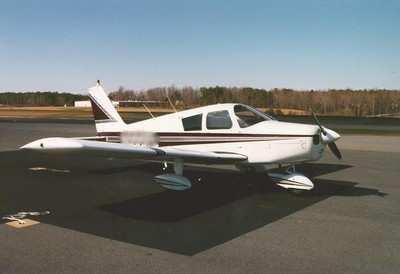25 Hour Student Pilot Was Flying To Visit His Girlfriend
 The NTSB has released a preliminary
report in an accident that killed a student pilot when he impacted
rising terrain en route to Cobb County-McCollum Field (KRYY) near
Atlanta on Christmas Eve. The student had not filed a flight plan,
nor had he obtained a weather briefing prior to the flight.
The NTSB has released a preliminary
report in an accident that killed a student pilot when he impacted
rising terrain en route to Cobb County-McCollum Field (KRYY) near
Atlanta on Christmas Eve. The student had not filed a flight plan,
nor had he obtained a weather briefing prior to the flight.
NTSB Identification: ERA10FA099
14 CFR Part 91: General Aviation
Accident occurred Thursday, December 24, 2009 in Heflin, AL
Aircraft: PIPER PA-28-140, registration: N1277T
Injuries: 1 Fatal.
This is preliminary information, subject to change,
and may contain errors. Any errors in this report will be corrected
when the final report has been completed.
On December 24, 2009, approximately 2200 CST, a Piper PA-28-140,
N1277T, was substantially damaged when it impacted terrain in
Heflin, Alabama. The student pilot was fatally injured. Marginal
visual meteorological conditions prevailed and no flight plan was
filed. The personal flight originated at St. Clair County Airport
(PLR), Pell City, Alabama and was destined for Cobb County-McCollum
Field (RYY), Atlanta, Georgia. The flight was conducted under the
provisions of Title 14 Code of Federal Regulations Part 91.
Preliminary information provided by the FAA and Lockheed Martin
Flight Service revealed the pilot did not obtain a weather briefing
or file a flight plan.
According to the pilot's family, the purpose of his flight was
to visit his girlfriend in Atlanta. The pilot had originally
planned the flight for the following day, but decided to fly on the
night prior instead. When the airplane did not land at its
destination, the family notified authorities and an Alert Notice
(ALNOT) was issued by the FAA. Search and rescue was initiated, and
the airplane was located in the Talladega National Forest on
December 25, 2009, around 1600 CST.
The airplane impacted rising terrain, in a heavily wooded area,
at an elevation of 1,244 feet. The airplane came to rest, upright,
oriented downslope on a heading of 120 degrees magnetic. The
terrain inclined at approximately 35 degrees. All components of the
airplane were located in a compact area, there was no wreckage
path, and trees in the surrounding vicinity were not disturbed.
The forward cabin displayed severe crushing and was compressed
aft from the instrument panel to the aft bulkhead area.
The firewall, engine, and propeller were buried in the ground
just forward of the fuselage structure and were not visible. The
throttle and mixture control levers were observed in the full
forward position. The altimeter displayed 960 feet, and 29.60 was
set in the Kohlsman window. The airspeed indicator displayed 190
miles per hour (160 knots), the vertical speed indicator displayed
a 750 foot-per-minute descent, the magnetic compass indicated 090
degree heading, and the VOR was set to 090 degrees.
Both wings remained attached to the fuselage at their forward
wing root attachment points. The leading edges of both wings
displayed symmetrical aft crushing. Both wing fuel tanks were
breached and their fuel tank caps secured. The empennage remained
attached to the fuselage, and little to no damage was observed to
the vertical fin, rudder, or stabilator. Flight control
continuity was confirmed from the cockpit area to the respective
flight controls. Both flaps appeared to be in the retracted
position.

Piper PA-28 140 File Photo
The pilot held a third-class medical
and student pilot certificate, issued on November 6, 2009. At that
time he reported 6 hours of total flight experience.
The pilot's logbook was located in the airplane. Examination of
the logbook revealed the first entry was for a flight on October
30, 2009. Entries continued until the last entry which was for a
flight from PLR to ASN on December 25, 2009, the day after the
accident. According to the logbook the pilot had accumulated 25
hours of total flight experience, all of which were in the previous
2 months. He had accumulated 6.5 hours of night experience, all
with an instructor.
According to the logbook, the pilot completed his first solo
flight on December 20, 2009 and his second solo flight on December
23, 2009, both in the traffic pattern at PLR.
The pilot had an endorsement in his logbook for solo flight
within 25 miles of Talladega Municipal Airport (ASN), Talladega,
Alabama. The endorsement included the following limitations: wind
10 knots, crosswind less than 6 knots, cloud ceiling 2,300 feet,
and visibility greater than 6 miles.
The pilot did not have an instructor's endorsement for a
cross-country flight. According to the pilot's instructor, the
pilot had not received any cross-country flight training.
According to documents in the airplane, the pilot purchased the
airplane on December 23, 2009.
Examination of recorded weather provided by an Automated Weather
Observing System (AWOS) at PLR, the weather at 2120 included wind
from 110 degrees at 11 knots gusting to 17 knots, visibility 5
miles, few clouds at 200 feet, a broken cloud ceiling at 1,600
feet, and an overcast cloud ceiling at 3,000 feet.
 ANN's Daily Aero-Linx (04.13.24)
ANN's Daily Aero-Linx (04.13.24) ANN's Daily Aero-Term (04.13.24): Beyond Visual Line Of Sight (BVLOS)
ANN's Daily Aero-Term (04.13.24): Beyond Visual Line Of Sight (BVLOS) Airborne 04.09.24: SnF24!, Piper-DeltaHawk!, Fisher Update, Junkers
Airborne 04.09.24: SnF24!, Piper-DeltaHawk!, Fisher Update, Junkers Aero-News: Quote of the Day (04.14.24)
Aero-News: Quote of the Day (04.14.24) ANN's Daily Aero-Term (04.14.24): Maximum Authorized Altitude
ANN's Daily Aero-Term (04.14.24): Maximum Authorized Altitude




